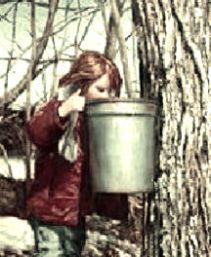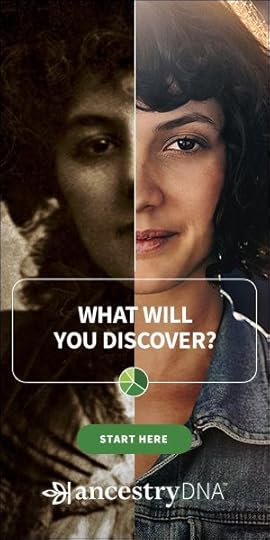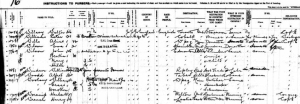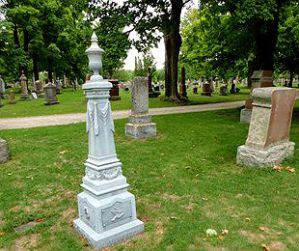Arlene Stafford-Wilson's Blog, page 44
March 7, 2021
Time to Spring Forward
The tail-end of winter dragged on like my math class at Glen Tay School, and I’d seen quite enough snow for one season. I kicked at the chunks of ice, as I trudged down the lane-way, to wait for the bus on the Third Line. I stood there cold and shivering those dark mornings, in early March. I could still taste the remnants of the bitter cod liver oil that Mother insisted we take every morning in the winter. I couldn’t even remember what it was supposed to do for us. It sure didn’t make me feel any warmer. I stared up the Third Line toward DeWitt’s Corners, and strained my eyes to see if the bus was coming. It wasn’t.
My teacher, Mrs. Conboy, told us that if March “came in like a lion” that it would “go out like a lamb”. I wasn’t really sure what she meant by that, but if she was talking about the weather, March, that year, had come in more like a ferocious white dragon, and had dumped another foot of snow on our yard. Just what we needed; more snow for my brother Roger and I to shovel after school.

Despite the fact that we’d tapped the trees, and had a nice jar of maple syrup sitting on the kitchen table, it really didn’t feel any warmer. I kept staring down at Mother’s flower bed still heaped with snow, wondering if those perennials would ever come up again. The only flowers I’d seen since last fall were the glossy photos in Mother’s tattered copy of McConnell’s Seed Catalogue. Lately, she’d been sitting at the old kitchen table in the evenings, staring at the pages of that seed catalogue as though it contained the secrets of the universe. Maybe she was dreaming about her flower beds; planning which seeds she’d plant, if those mountains of snow ever melted.

One of the things making me grow weary, and impatient for spring, was wearing boots. Put them on; take them off…on and off, off and on, month after snowy month. I’d been stomping around in boots since last November. It seemed like I was always weighed down with hats, and mittens and scarves and sweaters. No wonder some of the animals slept through the winter. It didn’t seem like such a bad idea on days like this. Maybe next fall I’d fill up a great big sack with Mother’s chocolate chip cookies, eat them until I passed out, and wake up again in the spring. If the black bears that lived in the bush near the train tracks could do it; why couldn’t I?

The weeks passed by and one night, after supper was finished, we were attempting to watch the news, on the old black and white television in the living room. Dad was standing over the set, moving the ‘rabbit-ear’ antennae back and forth, trying to get a clearer picture. Great, I thought to myself, there’s even ‘snow’ on the TV. Dad continued to fiddle around with the knobs at the back, and kept adjusting the antennae until he finally got a reasonable looking picture on the television. After Dad turned up the sound I heard the most beautiful words I’d heard for a long time. The man reading the news announced that Daylight Savings Time would be starting this Sunday morning.


Dad remarked from the comfort of his lazy-boy chair, that it was none other than Ben Franklin, who invented daylight savings time. At that point, I didn’t care who had invented it; I was just happy to hear that it was beginning soon. Mother said she’d have to remember to turn her alarm clock back on Saturday night before bed, so we wouldn’t be arriving late at Calvin Church on Sunday morning. Mother also said that it was going to be difficult getting up for school the first few days next week, because I’d really be getting up an hour early. I was so happy to hear the news that I would have gladly gotten up three or four hours early, just to have that extra hour of daylight after school.
I’ll never understand why some of those Lanark County winters seemed to drag on forever. Frigid days of boots and snow, and cod-liver oil, and days too cold to play outside, went on and on. Of all the seasons in the year why did the worst one last the longest? It reminded me of the way that we had to finish all of the vegetables on our plate before we’d get any dessert. Every scrap of broccoli, every mound of mashed turnip, every morsel of creamed corn had to be consumed before we’d get a slice of Mother’s moist, delicious chocolate cake.


So, maybe winter was the ‘vegetable’ part of the meal. Something we had to work our way through, before we got to the good stuff. It was something often mushy, just like the snow; sometimes bitter, like the cod-liver oil. Sometimes it was cold, like the broccoli that often sat on my plate until the end, when I couldn’t avoid it any longer. Spring was like the reward for suffering through the long winter; just like eating the chocolate cake after enduring those awful vegetables. I wondered to myself if spring would seem as sweet if we didn’t have to tolerate the long harsh winter first. After all, I knew for sure that after consuming a plateful of tasteless green mush, nothing could compare to the heavenly chocolate flavour, and sweet rich icing, on our Mother’s cake, still warm from the oven.
——————————————————————————————————————————–
March 6, 2021
Spring Came Up the Third Line
One of my friends from DeWitt’s Corners said that they’d seen a robin in their back yard, but I hadn’t seen one yet. The only sign of spring that I’d noticed was the steady drip of water, coming off of the old roof, in the late afternoons, when I returned home from Glen Tay School. That meant that the temperature was rising above freezing during the day, so the sap must be running again.
Sure enough, that same day, I saw Dad heading down the lane, toward the Third Line, and he had his carpenter’s auger in his hands. That old thing looked battered and ancient, but it sure did the trick when he needed to tap some trees. We didn’t have a big maple bush like Korry’s, across the road, but Dad always tapped a few trees along the laneway, so that we’d have enough syrup for the family.
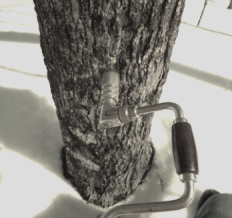

If anyone had bothered to stroll past the trees that we’d tapped, they likely would have laughed themselves silly. It wasn’t exactly a professional operation. None of the buckets matched. We had a grey metal pail, that hung on one of the spiles by a rusty wire. We also had a white plastic bucket, that Mother had made, by cutting up an empty corn syrup jug. Another bucket was made from an empty Billy Bee honey container. We even used one of my old sand pails, that I’d played with on the beach, when we went to Silver Lake in the summer. Any available container was ‘fair game’. It was only for a few weeks after all, and they couldn’t afford to be spending money on something that was used for such a short period of time each year.
Looking back, it didn’t really matter what kind of buckets you used, as long as you had something to collect the sap. I used to stand at the side of the tree, and watch as the clear, sweet liquid dripped ever so slowly, drip, drip, and splashed into the bucket below. I’d lift the bucket off of the metal hook, and dump the sap into Mother’s biggest mixing bowl, hook the bucket back on the tree, and carry the bowl gingerly up the lane way, and into the kitchen. Mother would be ready with a piece of clean cheesecloth, stretched over the big aluminum pot on the stove, and she’d take the bowl of sap, and dump it into the pot. The cheesecloth would catch all of the little specks of dirt, or bits of wood, that had come from the tree, so that the sap in the pot was nice and clean.
I guess if I’d been a little older, and a lot smarter, I would have asked Dad for one of the big pails from the garage, to transport all of the sap, in one trip, into the kitchen. Instead, I emptied one bucket at a time, into the big mixing bowl, and trekked all the way back and forth, up to the kitchen. Up the lane, and down the lane, I went over and over again, until I was finished; usually just before supper time. One night I forgot to empty the buckets, and the next night the sap was overflowing, running down the side of the tree, onto the snow. No one said anything about it, but I felt bad because I hadn’t done my job, and worse still we’d have less syrup because of it.
The air in the old kitchen smelled sweet for those few weeks each year, as the sap boiled away on top of the stove. Usually by the third or fourth day we’d have enough for a little bowl of syrup for dessert. The first syrup of the year was always the lightest in colour and in flavour, perfect for eating straight out of the bowl. Dad liked to pour a little cream into his syrup, and give it a stir. He’d take a piece of day-old homemade bread and dip it into his creamy syrup mixture, until he was down to the last sweet drops, and then he’d do one last sweep of the bowl with his bread.
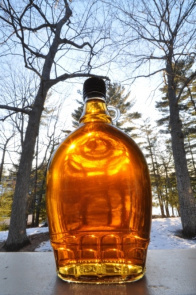
The other kids in the family poured their syrup over vanilla ice cream, but I liked mine straight-up, with nothing getting in between me and that sweet, perfect, maple flavour. I’d take a melamine bowl and teaspoon out of the old sideboard, pour myself a little, and enjoy it just like that.
As the weeks passed by, the syrup became darker in colour, and the flavour grew richer, and more intense. It was like magic watching the syrup change from a light honey colour to the rich, dark, amber toward the end of the run. The sap dripped slower and slower from the trees, as the days grew longer and warmer. When I waited for the big orange school bus to chug up the Third Line, it wasn’t as dark outside, nor as cold, in the early mornings,
The sun was shining a little brighter each week, and our driveway became a soggy obstacle course, as we stepped around the growing puddles of water. The snow banks finally shrunk, and shriveled away. Soon after, we’d take the buckets down, and put them away in the back porch for another year. Dad removed the spiles from the maple trees, wrapped them in a soft cloth, and placed them in the top drawer of his tool chest in the garage.
By then, the maple trees were beginning to bud, and a few of the familiar spring birds were returning to Mother’s bird feeder, in the back orchard. Almost all of the snow had shrunk down to a few dirty white mounds, spaced here and there in the yard, and the ground was spongy, cold and brown. The sun grew a little brighter each day, and stayed up in the sky later and later, after supper each night.

Spring wasn’t here yet, not even close; but all the signs were there that it was just around the corner. Each year when we tapped those maple trees, I knew that Spring was not far away. It was only a matter of time now that she’d be coming up the Third Line, with all of her delicate shades of green. She’d be bringing her warm sun, and her gentle breezes. She’d slip into our yard quietly one morning, and tell all of the flowers to wake up, and show their colours. She’d whisper to the squirrels and the chipmunks, and invite them to come back and play in our yard.

I often wondered if Spring could see us tapping our trees, and if that was her signal to make her way back into Lanark County, and into our yard. Maybe there was something magical about the syrup, and once we’d had our first taste, Old Man Winter knew that it was time for him to pack up his snow, and his cold winds, and head up north. Either way, we always knew that as soon as the sap began to run we’d be seeing Spring in all of her glory in no time at all!

February 10, 2021
Family History Tip: Researching and Remembering Our Veterans
Short days ago we lived,
felt dawn, saw sunset glow,
loved and were loved,
and now we lie in Flanders Fields.” — John McCrae
Over 600,000 men and women enlisted in the Canadian Expeditionary Force (CEF) during the First World War, (1914-1918) as soldiers, nurses and chaplains. The CEF database is an index to those service files, which are held by Library and Archives Canada.
This free online searchable database includes over 600,000 men and women who participated in WWI (1914-1918) including soldiers as well as nurses and clergy:
WWI Canadian Forces Personnel Records
These service files contain the name, address, service number, name of the next of kin, their physical description , skin colour, eye colour and scars or identifiable markings, and the unit number and location where they signed up for service.
On this site you can find links to the soldier’s file, which contain medical and pay records, and encompass a more detailed personal history of the soldier, and includes the specific units where they served, after going overseas. The soldier’s full service records are not available online, however, they may be ordered for a fee from Library and Archives Canada.
Also available are links to the Canadian Virtual War Memorial if the soldier died while in service.
War Diaries – This is a link to the diaries of the unit, not to personal diaries, but of the records of day to day life in a particular unit. This will give you great insight to how your ancestor lived in times of war in their group as they trekked across Europe and participated in various battles – some successful and some not.
Using the resources and links mentioned in this article, I was able to search and locate cousin Harry Stafford’s enlistment papers, his detailed medical files, including x-ray images and comments from attending physicians, his pay statements, physical description, and name and address of his next of kin.
I was also able to find out about the specific battle where he was wounded and subsequent hospitals in Europe where he received treatment. The records also state his date and condition at discharge, and pay records of any amount owing.
Harry’s story begins with the 130th Battalion, Lanark and Renfrew Scottish Regiment which was the ‘130th also known as the ‘overseas’ Battalion, based in Perth, Ontario.
They began recruiting in the fall of 1915, in Lanark and Renfrew Counties.
Harry’s StoryNine-year old Harry stood by the shore, and watched in horror as his eldest brother Wilfred struggled to the surface again and again, until he finally slipped out of sight into the deep blue waters of the Mississippi River near Lanark.
Harry and his brothers often played near the water, although none of them could swim. The four brothers stood on the shore that fateful day in July, and skipped stones on the surface of the water, just as they had so many times before.
Wilfred, two days shy of his thirteenth birthday, was the eldest of the four. He took great pride in showing his younger brothers how to pick the longest flattest stones. He coached them on how to hold the stones on their flat side, and throw them parallel to the water, so they would skip farther along the waves. Dick, at age ten, was beginning to get the hang of it. Harry and his twin brother Frank had turned nine two months before and were doing their best to keep up with the older boys.
Harry, the stronger and more athletic of the twins was trying to help his brother Frank as he struggled with the task. Frank had kyphosis which meant that he had a severe curvature of the spine. People in those days referred to Frank as a ‘hunchback’, but he was still able to do most things; although it might take him a little longer.
One of the boys had thrown his prized pocket-knife into the water by mistake, and Wilfred had gone into the water to retrieve it, slipped on a rock and fell into a deep hole, unable to swim, and drowned. The younger boys had raced back into Lanark to get help, but it was too late. By the time they had met up with the first grown-up it was already after five. Mr. Baker, the local tailor in Lanark hurried back to the spot, and pulled Wilfred’s lifeless body from the river.
Mr. Baker laid the body gently on the shore, and headed back to the Stafford home to deliver the news. Harry’s mother Mary (Murphy) Stafford was pregnant with her next child Carmel at that time, and both she and Harry’s father Peter were overcome with grief.
This would be Harry’s first, though not his last encounter with death at a young age. Two years later in the spring, his mother once again gave birth to twins – this time a boy and a girl – Rose Marie and Martin Wilfred, named for his late brother. The twins were born in the spring, and Harry’s parents were delighted to welcome the new babies into their growing family. Sadly, tragedy struck once again, and Harry’s new little brother Martin Wilfred, the weaker of the two passed away quietly, just seven weeks after his birth.
A few short years after the second tragic event in Harry’s family, war was declared in Europe. Canada was still under British rule at the time and as such would be expected to join in the war efforts overseas.
Within the next couple of years tales of the excitement and adventure on the front lines travelled back to Perth, and acts of heroism and valour were recounted in the local papers. Life on the farm, and the daily chores seemed mundane, compared with the glorified life of a soldier fighting for freedom.
The 130th Battalion, Lanark and Renfrew Scottish Regiment which was the ‘130th “Overseas” Battalion, CEF’ Based in Perth, Ontario, began recruiting in the fall of 1915 in Lanark and Renfrew Counties. When a recruitment officer arrived in the village of Lanark one winter, young Harry, just sixteen at the time lied about his age and signed up on the spot.
The Canadian Expeditionary Forces, as they were known, specifically recruited men between the ages of 18 and 45, so Harry claimed that he was born the same year as his brother Dick and was actually eighteen years old. They took him at his word, and Harry became an enlisted man on January 9th, 1916.
Harry, along with some local lads, was sent for basic training in Valcartier, Quebec and returned home for a brief visit before going overseas.
August 4 1916 – ‘The Perth Courier’“Corporals Ronald Scott, William Strang and Jack Scott (McDonald’s Corners) and Privates Lance Affleck, Ralph Craig, John Kingston, Harry Stafford, Henry Barrie (Watson’s Corners), and Joseph Bennett (Fallbrook) of the 130th Batt., Valcartier, are home on a week’s furlough – their farewell visit before going overseas.” (Harry was 17 by then)
The 130th Battalion left the Halifax harbour and sailed for Britain on 23 September 1916. After two weeks at sea, arriving in Liverpool, England on October 6th, Harry and the other members of the unit were absorbed by the ’12th Reserve Battalion, CEF. Their prime function was to provide reinforcements for the Canadian Corps that were already fighting in the field.
After fighting bravely in both England and France, Harry found himself participating in one of the most significant campaigns in WWI. Known as the Third Battle of Ypres (or Passchendaele) this battle was remembered both for its tremendous loss of life and casualties and because of the horrendous conditions of the battlefield.
The siege of Passchendaele went on for over three months from July through November 1917. More than 4,000 Canadians died and over 12,000 were wounded. The battlefield consisted of flat, swampy lowlands, and when heavy rainfall pounded the fields that autumn, the ground became a sea of mud. The men had to struggle through the thick mud with very little cover, while German soldiers tore them to pieces with their machine guns.
By November the Canadians were finally beginning to win the battle and began to push the Germans back from their stronghold. It was on the 6th day of November 1917 that 18 year old Harry was wounded in the leg by German gunfire at Passchendaele.
Harry was dragged out of the line of fire, received basic care from one of the medics to stop the bleeding and was sent to a hospital in England. He was admitted two days later on November 8th.
Word of Harry’s injuries was sent to his parents, back on the farm, in Lanark:” Mr. and Mrs. Peter Stafford received a telegraph from the Director of Records, Ottawa, on Friday, informing them that their son, Pte. Harry Stafford, 787104, had been wounded by gunshot in thigh and leg on Nov 6th, and admitted to No. 6 Field Ambulance Depot. Harry went overseas with the 130th Batt. in September, 1916, was transferred to another battalion for service in France, and has been through some severe engagements since crossing the channel. His many friends hope that Harry’s wounds are not serious.”
—-21 November, 1917, “The Lanark Era”The medical care during WWI was a very complex set of institutions, which cared for wounded soldiers from the battlefield, as soon after injury as possible. The soldier was evacuated as quickly as possible for treatment, and provided care.
The Field Ambulance was a mobile unit equipped with horse-drawn ambulances. They brought soldiers from the battlefields to an Advanced Dressing Station located at the rear of the siege out of harm’s way.
After Harry was shot, the first day he was sent to the #6 Field Ambulance Nov 6 1917, and after a month’s time was transferred to the Pavilion General Hospital Brighton Nov 23 1917, for three weeks.
Harry’s condition was not improving, and he suffered infection after infection. He was transferred to the Military Convalescent Hospital at Woodcote Park, Epsom, England on Dec 22, 1917 and he remained there receiving treatment for four and a half months.
In March 1918 he was transferred to Bramshott Military Hospital, where he was treated for one month, with still no sign of improvement.
It was during this time that Harry received word from his parents at home that his brother Carl had enlisted in a month earlier, and like Harry had lied about his age in order to join the service.
On July 8th, 1918 Harry was admitted to the Granville Canadian Special Hospital in Buxton, Derbyshire, England.
In November of 1918 WW1 finally ended. Losses of human life by Canadians and the allies were in the thousands.
After six months of unsuccessful treatment at the Granville Hospital in England Harry was finally discharged on December 3rd, 1918.
His condition continued to deteriorate, and on December 23 1918 Harry embarked for Canada sailing on the S.S. Tunisian.
Due to his medical condition, Harry was discharged from the military at Ottawa, on February 5, 1919.
Jan 10 1919 Perth Courier:“Pte. Harry Stafford, son of Mr. and Mrs. Peter Stafford, Lanark, returned home Monday from overseas. He went overseas with the 130th Batt. In November 1917 he was wounded in the leg and latterly has been receiving hospital treatment in England.”
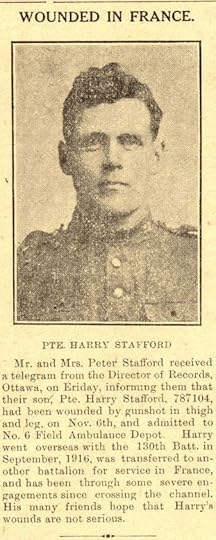
Harry’s condition never improved, and once again he was admitted to St. Luke’s Hospital in Ottawa on February 4th, 1920. He developed a cold two days after being admitted, and his operation was postponed until Feb 9th. Pneumonia developed 12 hours following operation, and Harry died two days later. There was speculation at the time that he may have contracted the flu while in the hospital, and that it turned to pneumonia in his already weakened state.
The influenza pandemic of 1917-1920 was a global disaster, and was actually responsible for killing more people than WWI. It has been said that it was the most devastating flu epidemic in recorded world history.
Because of the close quarters and huge troop movements during the war it is possible that these two factors hastened the pandemic and likely increased transmission of the virus. Many soldiers’ immune systems were weakened by lack of proper nutrition, the stresses of combat and chemical warfare, increasing their susceptibility to any illness.
Feb 20 1920 –“Died: In St. Luke’s Hospital, Ottawa on Thursday February 12th, Harry Alphonsus Stafford, son of Mr. and Mrs. Peter Stafford of Lanark, aged 20 years and 9 months.”Because he died at St. Luke’s Hospital in Ottawa, Harry’s death was registered in the County of Carleton, Division of Ottawa. His official cause of death was listed as pneumonia.
After a quick search on Ancestry.com, I found Harry’s death certificate:
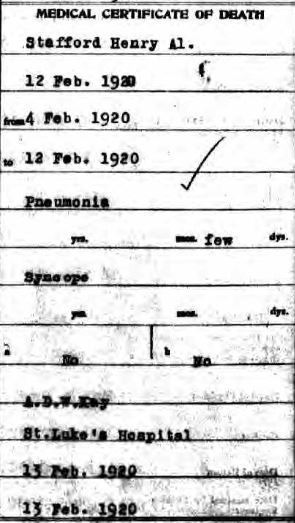
Harry is buried at the Sacred Heart Cemetery, Lanark, Ontario
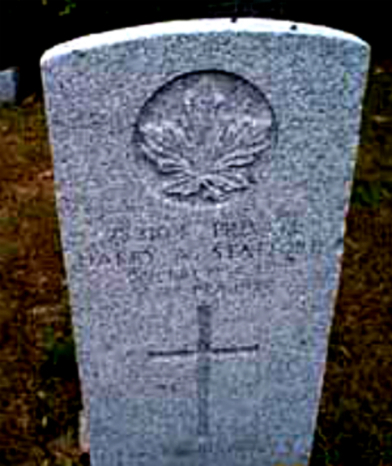
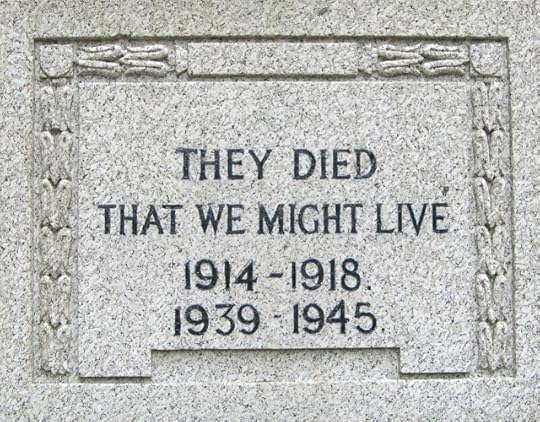
……………………

Are you researching a Canadian Soldier?
There are several resources listed below to help with your search.
……………………………………….
(the above is an excerpt from a book on the life and military service of Pte. Harry Stafford. The hard-cover book is available for research purposes at the Lanark Museum, 80 George Street, Lanark Ontario lanarkanddistrictmuseum@gmail.com, and at Archives Lanark, 1920 Concession 7 Road, Drummond Centre, Perth, Ontario adm.archiveslanark@bell.net)

 Lest We Forget
Lest We Forget………………………..
Link to: Canadian Soldiers of WWI
Link to Commonwealth War Graves
Link to Names in Book of Remembrance
…………………………
Tip:
Many other records, can be located quickly and easily on Ancestry.com.
February 8, 2021
Genealogy Tip: Free Online Searchable Surname Origins & Meanings
Have you ever wondered about the origin and meaning of your surname? Would you like to know the location in the world where your surname was first used?
Today, there are many free online searchable databases where you can find out more about your surname. With these helpful links below, you will find that family names may be derived from: nicknames, physical attributes, counties, trades, heraldic charges and many other sources.
Please note that some individuals and families have changed their names at some time in the past, so the surname that you use today, may be a variation of the original that was possibly written in another language.
History of Surnames:
Meaning and History of your Surname: http://www.ancestry.ca/learn/facts
Surname Database: over 49,500 names:
(While this database offers products for sale, it’s still worth a look, as it provides a good description of the surname origin)
Origin and Meaning thousands of Surnames:
For more free Genealogy Tips and Links:
https://arlenestaffordwilson.wordpress.com/category/genealogy-tips-help-links/
February 7, 2021
Genealogy Tip: Free Searchable Online Passenger Lists
Have you ever wondered how and when your ancestor crossed the ocean to Canada or the U.S.? For those who arrived in the 1800s and later, it wasn’t until the early 1920s that commercial flights were offered, and even then, only available to the very wealthy. In the 1930s and 1940s, many still travelled by passenger ship.
Anyone travelling by ship was recorded in a ‘passenger manifest’, and depending on the line, the information recorded could be either very basic or extremely detailed. At the very least, a passenger manifest will tell you the date that your ancestor set sail, the name of the city or port where the ship originated, and a list of the names of every passenger.
More detailed ship’s manifests will also list your ancestor’s nationality, age, their occupation, and their final destination. It may even list the name of the person and address where they will be visiting or where they intend to live.
The image above is the passenger manifest which lists my great-grandfather William Woolsey, with two of his daughters – Grace and my grandmother Dorothea Woolsey. The ship’s manifest shows that the year is 1909, they are travelling from England and their final destination is Winnipeg, Manitoba, Canada. It lists my g-grandfather’s occupation – a butcher and lists the occupations of my grandmother and her sister – housekeeper and shop girl. This is typical information that may be gathered from a ship’s manifest and adds another element to your genealogical research.
Listed below are three of the top free searchable online databases listing passengers immigrating to both Canada and the U.S. :
Collections Canada – also includes American records in the case where the port of entry was in the U.S. and the passengers either remained in the U.S. or continued on by train to Canada.
The databases include – Passenger Lists, Border Entry and Immigration records
https://www.bac-lac.gc.ca/eng/discover/immigration/immigration-records/passenger-lists/Pages/introduction.aspx
The Ships List
Over 3,500 free passenger lists to Canada, U.S, and Australia
http://www.theshipslist.com/
The Immigrant Ships website has over 14,000 records of passenger manifests
http://www.immigrantships.net/
Good Luck with your search! Please leave any questions or comments below.
February 5, 2021
‘Genealogy & DNA’ – with the LCGS
After a long, cold, winter, and many weeks of cloudy skies and rain, the warm sunshine arrived, just in time, for the May meeting of the Lanark County Genealogical Society.
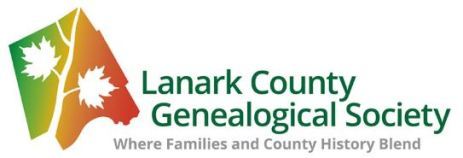
It’s always a pleasure to exchange ideas with fellow LCGS members, learn about new genealogy projects, and ongoing efforts to preserve our history and heritage, and helping distant families around the world, reconnect with their pioneer roots.

Also present, Helen Gillan, historian, tireless volunteer, and one of the founding members of the LCGS.
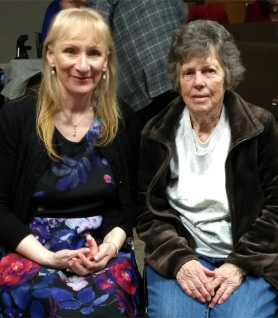
My presentation included a brief overview of the stories included in “Lanark County Calling: All Roads Lead Home:
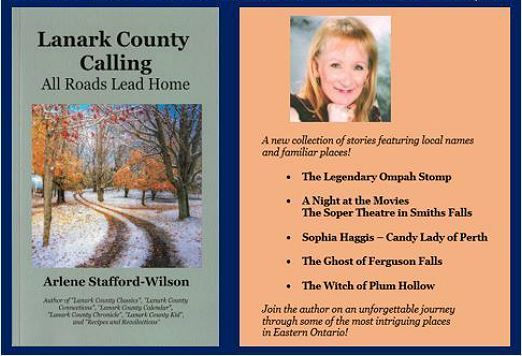
The main topic of the afternoon was a presentation and discussion of “Genealogy and DNA”.

In the presentation, I compared three of the most popular DNA Home Test Kits: ‘My Heritage’, ’23 and Me’, and ‘Ancestry’.

A contrast of the many varying price ranges for the DNA test kits was discussed, how each test is done, which tests are easier to use, and how soon the DNA results will be returned to the consumer.
Next, we examined some of the main features of each kit. Some DNA kit companies provide maps of the world, with a numerical breakdown of where your DNA match ‘cousins’ may be found, and how many are in each country.
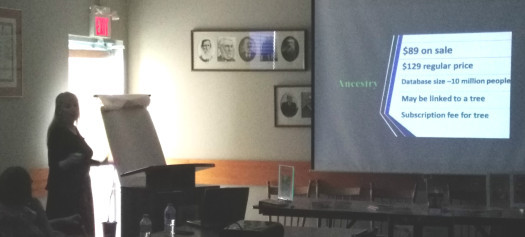
Other kits focus more on the medical aspects of DNA, and will provide the consumer with specific information on whether they are a carrier for a variety of diseases, like Parkinson’s, Alzheimer’s, blood-sugar disorders, cancers, macular degeneration, gluten-related disorders, nerve, heart, and blood disorders.
Some of the DNA test kits provide more comprehensive information on family connections, and will show how many cousins/DNA matches are in a particular part of the world, displayed on a map, and if you choose to build a family tree, these DNA tests will provide you with matches to the people in your tree, so that you may expand your family history through cousin connections.
The presentation included the different types of family-tree building software that comes as part of the kit, the ease of use of each of these, and also the ability to upload or download your DNA results into genetic ‘pools’, like those in GEDmatch, to provide you with an even wider search capability.
I also discussed some of the issues with privacy and DNA, how some DNA test providers share our DNA results with insurance companies, drug companies, and law enforcement. We also examined many of the newest features available to the consumer.
The presentation concluded with a question and answer session, and many interesting points of discussion took place, among those attending. Some had already taken one or more home tests, and they shared their personal views on the pros and cons of each type of test.

Following the presentation, the book table was busy, and many stopped by to discuss the stories in ‘Lanark County Calling’, and have a copy or two signed for themselves, and signed as gifts for others.
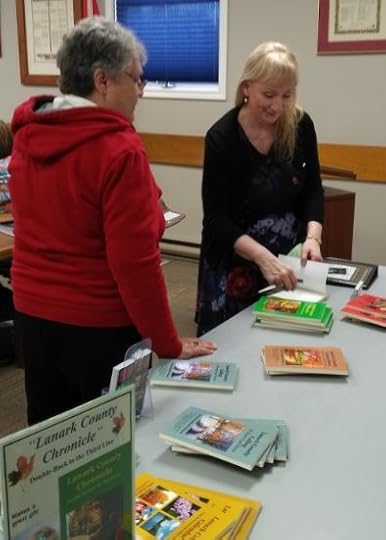
Karen Prytula, LCGS Director of Communications and Marketing, was busy throughout the day, coordinating the audio-visuals, and sharing updates with members. Karen very kindly presented me with a jar of Polk Honey, as thanks for the presentation.
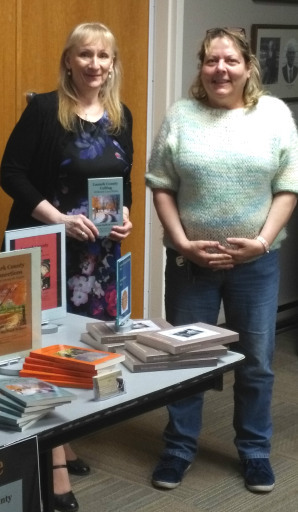
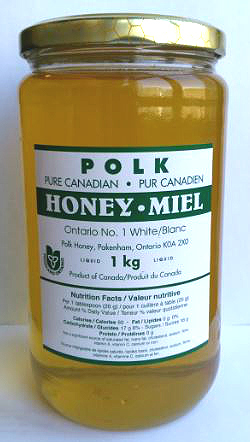
Polk Honey is produced in Pakenham, by Arnold Polk, and is one of the county’s most sought-after treats. If you’d like to try some yourself, it is available at the Pakenham General Store, 2524 County Rd 29, Pakenham, Ontario.
…..
Following the presentation, a delicious lunch was provided, and one of the highlights of the afternoon was a lovely display of some of Lanark County’s Heritage Quilts:

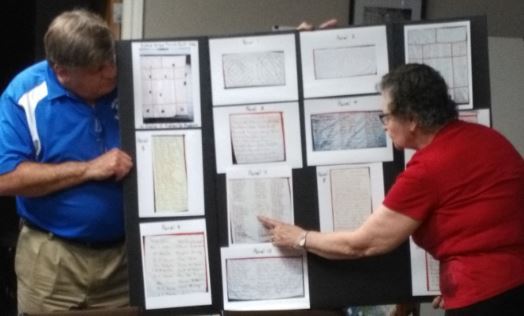

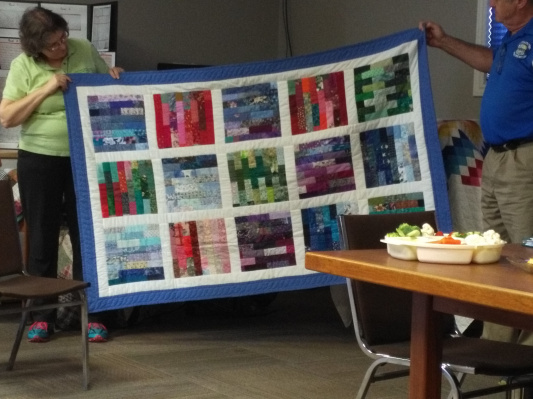
Many thanks to the Lanark County Genealogical Society for inviting me to be with you, and present ‘Genealogy and DNA‘. It was a wonderful afternoon, a chance to catch up with old friends, and to learn about ongoing projects, as the LCGS continues their work to preserve our heritage and history.
……
For more information on the Lanark County heritage quilts, please contact the LCGS: Lanark County Genealogical Society……
If you missed the talk on ‘Genealogy and DNA’, I will be presenting this to the Smiths Falls Historical Society, September 19th, 2019, at 7:00 p.m. All are welcome. For details, call 613-283-6311.
……………….
Irish Settlers & the Ghost of Burgess Township
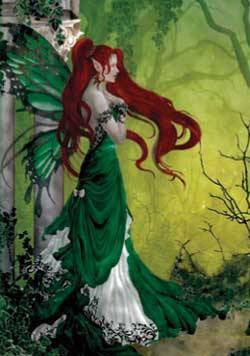
Burgess Ghost
The story of the Burgess Ghost begins with the arrival of so many Irish to the areas around Westport, the Scotch Line, Black Lake, and Stanleyville, that it became known as the ‘Irish Invasion’.
This is the the home where the story took place, in the cold, bitter winter of 1935, at the home of Mr. John Quinn. John lived in the house with his wife, and two sons Michael age 13, and Stanley, 11.
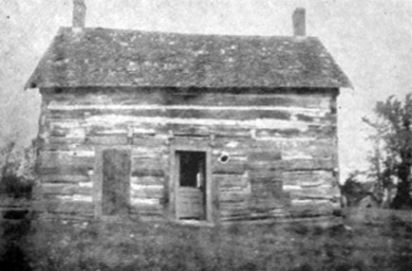
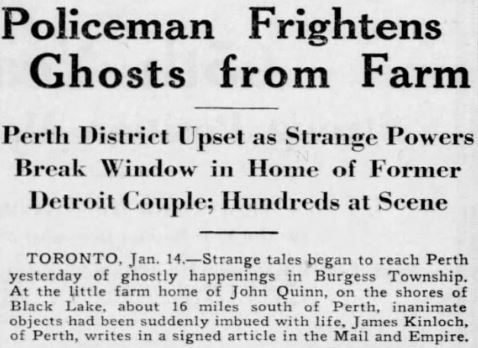

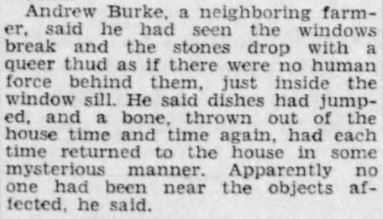


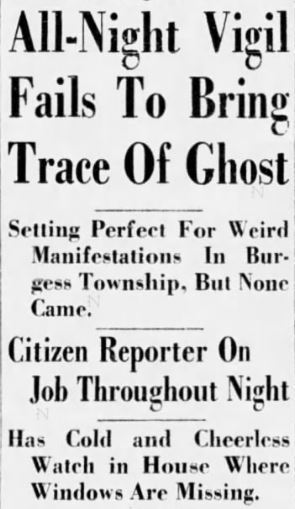
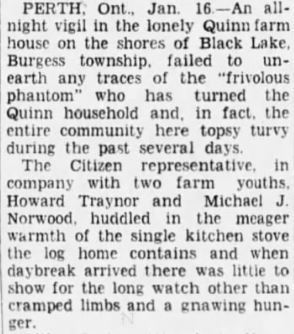
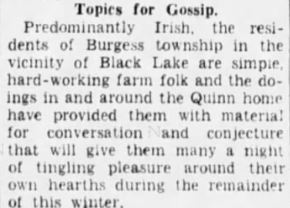
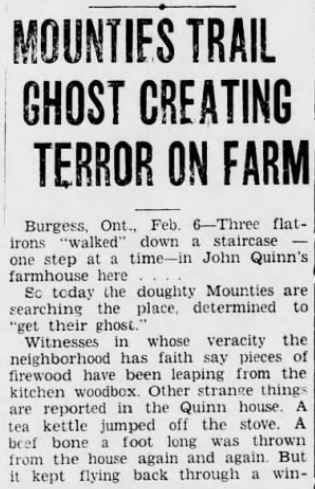
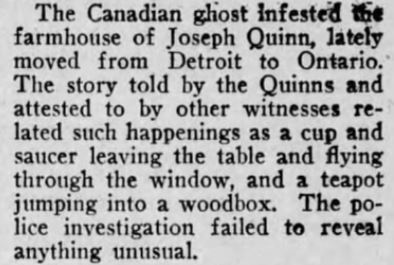
Don Rennie, reporter for “ The Perth Courier” , wrote a story on the Burgess Ghost in 1967:
“Strange occurrences were happening in 1935 at a farm in North Burgess just off the Narrows Locks road. Mr. John Quinn, his wife and two children, Michael, and Stanley, ages 13 and 11, reported innumerable phenomena taking place in their home. Stove lids, according to the Quinns, “danced” in the air, the teapot “jumped” off the stove into the wood box, three flat irons “walked” down a staircase and dishes “pranced” on the dining-room table. Word of this mysterious goings on spread quickly throughout the district. Although, perhaps skeptical, hundreds of persons from miles around flocked to the Quinn home.
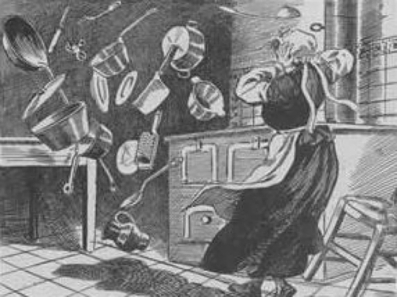
On the Sunday after the reporting of the “ghosts” more than 100 cars arrived at the Quinn farm. Along with the cars a flotilla of cutters and sleighs dotted the white-capped farm. The snow fell incessantly and the thermometer dipped way below the zero mark.
Newsmen from across the country arrived, and the CBC news from Toronto, reported the strange events. Although the strange occurrences could not be readily explained, many held doubts in their minds as the credulity of the phenomena. Believing that there had to be a reasonable explanation behind the occurrences, the Perth detachment of the OPP decided to hold an investigation.
On a Saturday afternoon, members of the force motored to the Quinn home, and inspected the building. Nothing strange occurred while they were there. That same evening Inspector Storey returned to the house. He remained there until Sunday morning along with about a dozen district men, sat in the house, speaking in hushed tones, but again nothing happened.
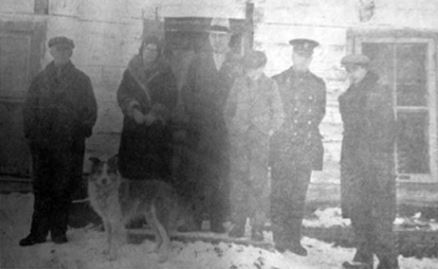
Mr. Quinn was unable to explain the strange occurrences that had been going on for the past couple of weeks. Pieces of beef he had placed in a barrel had been found littered throughout the house, he said, and the Wednesday before a window pane crashed for no apparent reason. He had not thought that too odd until it happened the very next evening.
Andrea Burke, a neighbouring farmer, declared that a bone thrown out of the home time and time again had always returned to the house for no explicable reason. Another neighbour, William Cordick, swore that he had seen three flat irons descend the Quinn’s staircase one after another.”
………………………………………………………………………………………………………………………………………..
Irish Settlers to North Burgess Township, Lanark CountyMost, but not all of the Irish in North Burgess Township, came from County Down and County Armagh, and many came in the 1840s, to escape a horrible famine, that swept through Ireland like an unstoppable plague. A disease called Potato Blight ravaged their crops for nearly a decade, and during that time over a million died of starvation, and an equal number fled Ireland on ships sailing to Canada and the United States.

Most were tenant farmers, leasing their land; unable to pay their rent when their crops failed, and were evicted by ruthless landlords. They bundled up what little they had, and boarded ships headed for the new world.
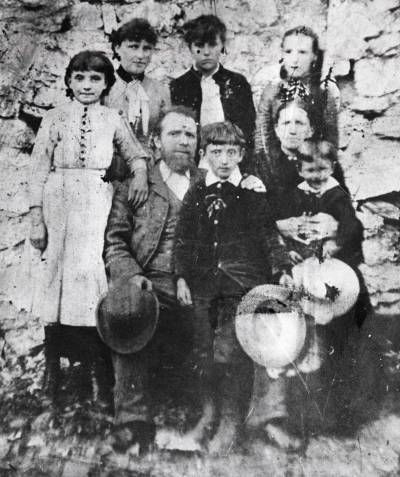
Seven weeks was the average length of time spent at sea, and the conditions endured by these Irish immigrants were so terrible that the ships were nick-named ‘coffin ships’. The lice, ticks and fleas common in these over-crowded vessels were the ideal breeding grounds for the transmission of disease, and by 1847 an average of 50 passengers died each day of typhus on their voyage from Ireland.
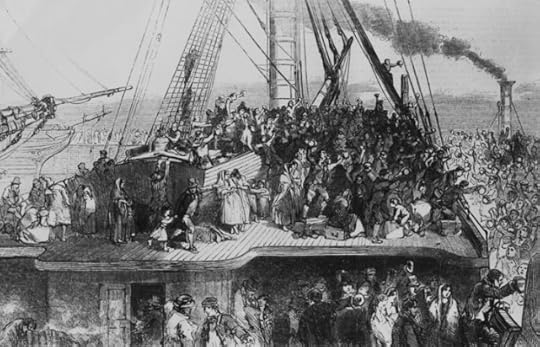
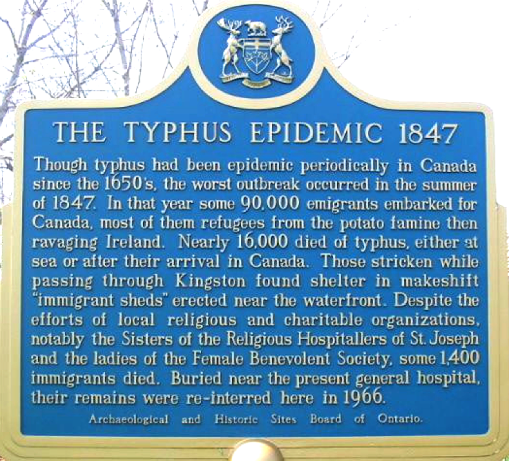
The areas where this ‘wave’ of Irish settled in Lanark County:

These new settlers brought their traditions, customs, and stories with them to the new country. Stories and legends were passed down from father to son, and from mother to daughter. Tales from the old country were told in the evenings by the fire, and the one story that seemed to run up and down the concessions in North Burgess was the legend of the Irish Banshee.

The Banshee, or ‘Bean Sidhe’ is an Irish spirit, and her high-pitched wail foretells of a death in the family. It was said that each family had its own Banshee, and that they travelled with them from the old country. Some said that the family’s Banshee would stay in Ireland at the family’s estate, and mourn the dead. The settlers to the new land brought their vivid descriptions of the Banshees – some claiming that she was an old hag with red eyes, but others said she was a fair, pale Irish beauty with long red hair dressed in a flowing gown.
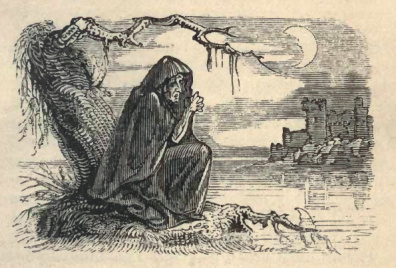

It’s been said that whoever hears her high and piercing shriek could be sure that there would be a death within 24 hours. Irish lore tells that the Banshee always wailed when a family member dies, even if the person had died far away, and news of their death had not yet come. The wailing of the banshee was the first warning to the household of the death.
When several banshees appeared at once, it was said to foretell of the death of someone prominent, or of an accidental or unintended death – often of a murder victim, a suicide, or a mother who died in childbirth.
The early settlers in North Burgess passed down their stories of banshees, fairies, ghosts and the little people. Although they were fiercely loyal to God and to the church, they never abandoned their beliefs in the spirits and creatures of their ancient folklore.
The Story of the Burgess Ghost became a local legend….The story of the ghost in the Quinn house was passed down through the years, told and retold at family gatherings, around campfires, and particularly in the weeks each year leading up to Hallowe’en.
In a strange final twist to the mystery of the Burgess Ghost, the Quinn family home burned to the ground. The cause of the fire was never determined, and remains a mystery to this day…..
In 1972, the Quinn home was burned to the ground.

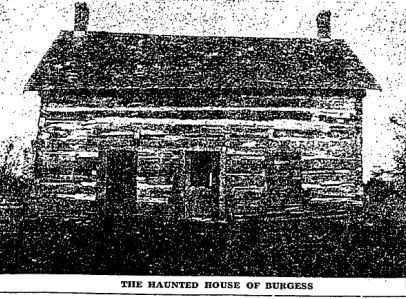
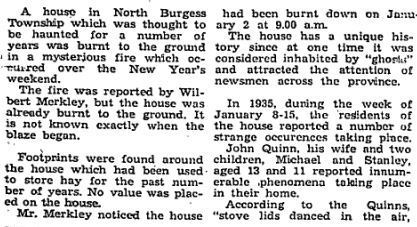
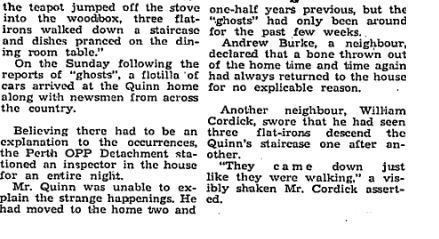
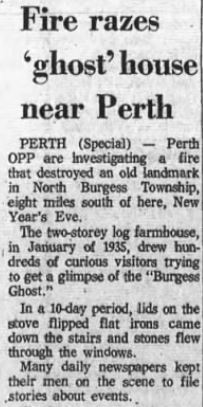
………
In 2002 the townships formerly known as North Burgess, South Sherbrooke and Bathurst were part of an amalgamation, and adopted the name of Tay Valley Township, as they are known today.
……..
For genealogical records of the founding families of North Burgess Township:
http://www.rootsweb.ancestry.com/~onlanark/nburgess.htm
National Archives of Canada – Immigration Databases Online Searh – Immigration to Canada
St. Bridget’s Cemetery Staneyville Ontario
Roman Catholic interments North Burgess Township
Scotch Line Cemetery – Burials from 1822-2000 North Burgess Township
Scotch Line Cemetery – North Burgess
Irish Immigration to Canada
Irish Immigration to Canada National Archives
Lanark County Genealogical Society
Archives Lanark
http://archiveslanark.ca/index.php
Search the census records for North Burgess Township, Lanark County
Searchable online census records for Lanark County
Irish Genealogy Records online
……………
For more information on Irish Folklore in the early days of Lanark County:
‘Banshees of Burgess’, is part of a collection of short stories in ‘Lanark County Classics – A Treasury of Tales from Another Time’. The reader will discover more about the early families from Ireland who settled in Lanark County, and their customs and beliefs in the supernatural, brought from the old country. The story explores some of the tales passed down by these Irish settlers, and documents their personal experiences with Banshees, ghosts, and fairies while living in Lanark County.
Available at The Book Nook, The Bookworm, Mill St. Books and online.“Lanark County Classics” – ISBN 978-0-9877026-54
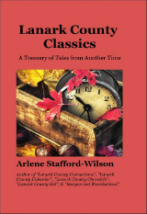
…..
(map of Northern Ireland – By Maximilian Dörrbecker (Chumwa) – map by NNW, CC BY-SA 2.5, https://commons.wikimedia.org/w/index.php?curid=7918534)February 1, 2021
Genealogy Tip: Free Online Searchable Grave Markers in Canada and the United States
Although there were some pioneer settlers who could not afford a gravestone or marker, the majority of our ancestors had headstones. Because of the long-lasting qualities of materials such granite, marble, bronze, concrete or sandstone used for these grave markers, many have survived the centuries and are still standing today. By including photos and written records of these grave markers in our family histories, we pay tribute to these ancestors and preserve their memory for future generations.
Most cemetery offices today, have interment records databases, and can quickly find where your ancestor is buried, even if you have only an approximate idea of when the person died.
At many cemeteries you can provide a surname and they will be able to print out a list of all people with that surname who are buried in their cemetery. If your ancestor is on the list then they can usually provide you with a small printed map of the cemetery showing the approximate location. Someone from the cemetery staff may even escort you to the exact burial plot location – even if there is no existing headstone.
Below are some excellent free online databases where you can search for gravestones in Canada and the United States. Good luck with your search and I encourage you to leave a comment and share your finds and success stories!
Find a grave in Canada
https://canadianheadstones.com/search.html
You may search by surname and/or province
Gravemarker gallery – Canadian
http://www.rootsweb.ancestry.com/~cangmg/
Find a headstone in the U.S.
Find a grave
http://www.findagrave.com/cgi-bin/fg.cgi
———-
Search for a War Veteran grave – (Canadian)
http://www.veterans.gc.ca/eng/collections/virtualmem
War veteran grave (United States)
http://gravelocator.cem.va.gov/
Ontario:
http://www.findagrave.com/cgi-bin/fg.cgi?page=gsr&GSln=Abbott&GSiman=1&GSst=830&;
For headstones in Ontario – Many of these entries include photos of the actual monument or headstone
Until next time – Best of luck with your genealogical research!
Arlene Stafford-Wilson http://www.staffordwilson.com –
Maple Trailblazers: Founding Families of Lanark County’s Maple Legacy

Did you know that the very first Festival of the Maples was held in Perth, Ontario back in the 1970s?
The story that follows is dedicated to the Lanark County families who played such a significant role, back in the early days, leading up to this annual festival in Perth: Andrew and George Korry, Bowes family of Glen Tay, Ernie and Evelyn Miller family of Glen Tay, Robert McEwen of Prestonvale, Ken VanAlstine of Maberly, Leonard and Tom Adam of McDonald’s Corners, Brien and Marion Paul west of Hopetown, Lanark, James ‘Carman’ and Edna Gibson of Dalhousie Township, Don and Marion Dodds of Clayton, George Coutts of Rideau Ferry, Wheeler family of McDonald’s Corners, and Fulton family of Pakenham to name a few.
Taffy on the TayYears ago, many of the local farmers produced maple syrup. Some made just enough for their families, and for others it was a supplement to their farm income, at a time of year that was less busy, than during the summer months. There were also a few dealers in the area that sold sugar bush supplies – Max Miller of Snow Road, Percy Drysdale of McDonald’s Corners, and W.J. Ballantyne in Lanark. James Brothers Hardware and the Co-Op in the town of Perth also sold supplies for maple production. Labels for the bottles were often printed by ‘The Perth Courier’.
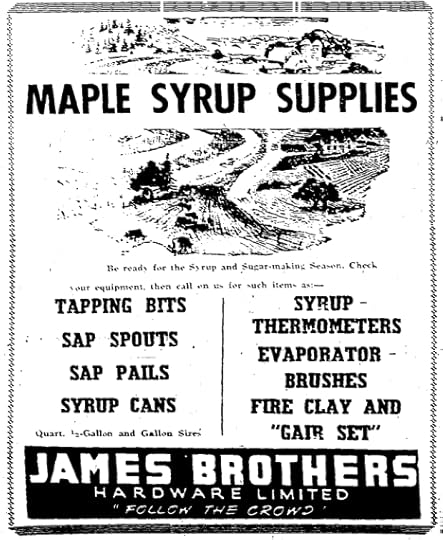
The Korry family farm was located across the road from our farm. They owned a medium sized sugar bush, and produced enough syrup to sell locally. Andrew Korry’s son-in-law John Chaplin sold it through his business – Chaplin’s Dairy, door to door, to their customers on the milk routes. Andrew and his son George were very busy for several weeks each spring making syrup, and my brother Tim Stafford worked with them in the bush one season. Extra help was always welcome. They used a team of horses, with a tank mounted on the sleigh, to draw the sap back to the evaporator, at the sugar shack; typical of many other producers at that time.
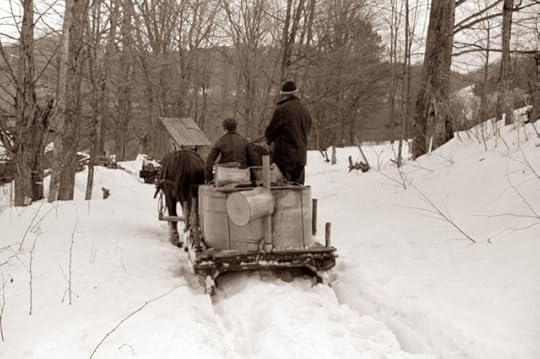
The Bowes and the Miller families of Glen Tay also produced their own syrup. I recall that Art Bowes used to tap quite a number of trees in the mid-sixties. Their land was known as Tayview farm, and it straddled the Tay River -a beautiful setting. At that time they had about 300 acres including hay fields, pastures, and of course maple bushes. Art’s son Doug traveled along with us on our school bus each day in the 1960s, and he often spoke about helping his Dad back in the bush each spring.
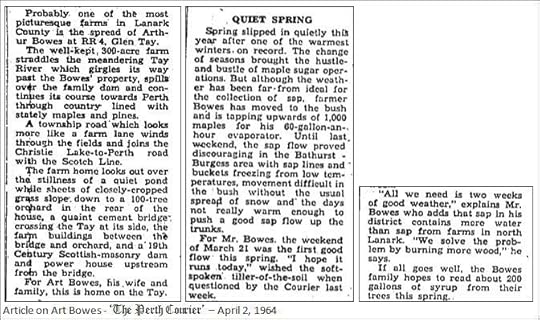

The Miller family’s farm, known as Tayside was owned by Ernest ‘Ernie’ Miller and his wife Evelyn (Mather). The Miller family arrived from Scotland in 1809, and their farm was purchased by Ernie’s great grandfather Dodds in 1858. Their kids were Diane, Nancy, John and Ruth. Evelyn was a lovely, soft-spoken lady, and she was my first 4H club leader. I also recall that Ernie was tapping about 1,500 trees back in the sixties, and had about 30 acres of maple woods. Ernie was a forward thinker, and one of his ideas at that time was that sap should be gathered by trucks from each farm, and taken to a large central evaporator – similar to the way that milk was trucked to cheese factories. It seemed through the years that Ernie was into everything. When he wasn’t farming he wrote history books, he researched genealogy, he worked with young people, and it was no surprise to me when he was inducted into the Ontario Agricultural Hall of Fame in 2003.

The McEwen clan in Ferguson Falls was another family who made their mark in the maple syrup business back in the 60s. In 1966 Robert McEwen of Prestonvale opened up the first pancake house in the area. Originally, Robert made his syrup the old fashioned way, out in the bush, and boiled a cauldron of sap over the fire. Later, in the 1970s I remember that he was one of the first to use plastic pipelines to bring the sap from the trees to one main location. Our Dad knew the McEwen family well, having grown up in that area, and said that Robert often spoke of the difficulties involved in syrup production. It was difficult to find reliable labour, and also challenging was finding the capital to purchase new equipment. Robert was very active in the local industry, and at one time was the President of the Lanark and District Maple Syrup Association.
When the former McEwen Sugar Shack went up for sale, Charles Temple and his wife Susan Snyder bought the property – the very first day it was on the market. The property known now as Temple’s Sugar Bush consists of 70 acres of maple bush where 5,000 trees are tapped annually.

…..
Ken VanAlstine in Maberly tapped over 2,000 trees when I was a kid, and he was among the first to use pipelines. He experimented at first, and tapped just 200 trees using the pipeline system, but the rest was collected in buckets, the traditional way, and transported to the evaporator by horse and sleigh.
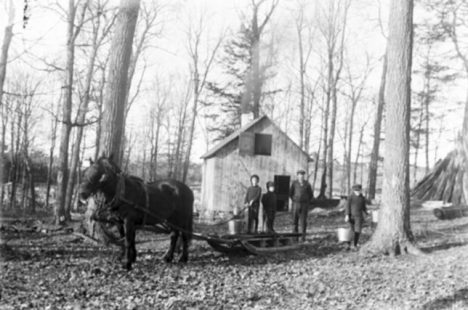
Ken, like other producers in the area, found the cost of hiring labour prohibitive, and found that distributors wanted too much money per gallon. Ken was well known in the area for his excellent quality maple syrup, and said on his best day at that time he gathered 3,300 gallons of sap.

…..
The Ennis family also has a long history of maple production. Their ancestor Arthur Ennis came from County Cavan, Ireland to Lanark County in 1840, and the family has been producing maple syrup for almost a century. Their sugar bush is located on the eastern shores of Bennett Lake, at the end of Ennis Road, Balderson, in Lanark County. Five generations of the Ennis family have been tapping trees on this property.

Another local family of long-time maple producers is the Adam family of McDonald’s Corners. Leonard Adam and his brother Tom tapped an average of 2,250 trees, and owned about 500 acres of land between them. They were hard workers, and spent many days sawing, chopping, and stacking the 20 cords of wood required for their evaporator. The Adam family were one of the first to use a brand new style of evaporator which was 4 by 14 feet. They produced enough to sell locally, and the remainder was shipped out West.
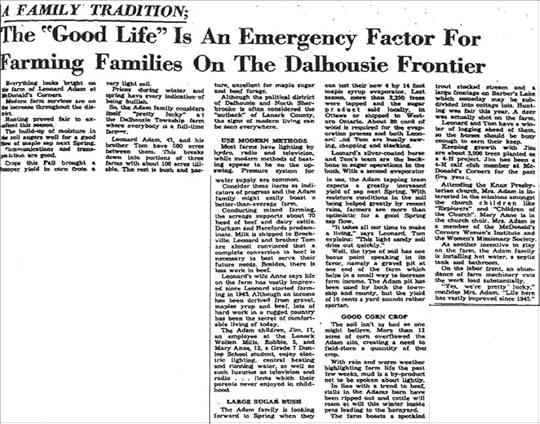
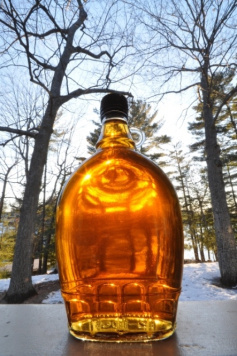
Brien and Marion (McLaren) Paul of R.R #3 Lanark owned a 575 acre farm, about three miles west of Hopetown, and began maple production in 1953. Marion was raised on a farm near the village of Lanark, was known locally as the ‘First Lady of Maple’, and served proudly as a Maple Judge at the Royal Winter Fair in Toronto. Their kids Kathy, Wayne and Darrell were also very involved in maple production, and provided additional labour for the family business. In 1972 Kathy was crowned Maple Queen in the local competition.
Back in the 1960s the Paul family used two sleighs, one pulled by a tractor, and the other by a team of horses. Brien’s father Raymond Paul often tended the evaporator, keeping a watchful eye as the sweet, fragrant, steam boiled off into the air. Russell Foster and Raymond Watt often assisted the Paul family with their production. They tapped an average of 4,000 trees at that time, produced about 700 gallons of syrup, and used approximately 30 cords of wood during the season.

The Paul’s were pioneers in the maple industry, and were very modern in their approach. They were one of the first to install plastic tubing, and an oil fired evaporator. The plastic pipes were attached to the tree spiles, and the sap flowed through the pipes, and emptied into a storage reservoir located behind the evaporator. Brien and Marion were inducted into the International Maple Hall of Fame, and were proud members of the Ontario Maple Producers and the Lanark and District Maple Producers Association.
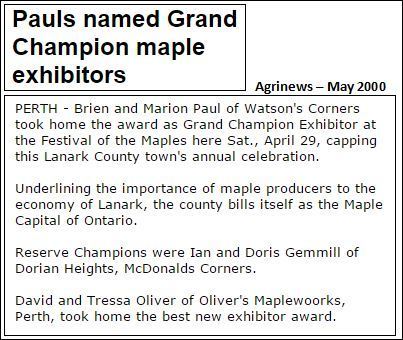
…..
Gibson was a name known for their excellent syrup. James ‘Carman’ Gibson, and his wife Edna (Rodger) had a maple business in Dalhousie Twp at R.R. # 4, Lanark. The nearby areas of Hoods and Poland were well known for their fine quality maple syrup. The Gibson family began tapping trees in 1821 with the arrival of James Gibson from Lanark, Scotland. He was the first pioneer settler in the area, and named their new home Lammermoor after the Lammermoor Hills in Scotland. Their five children Verna, Beatrice, Norma, Carol and Earl helped with the operation. The Gibson family also raised beef, dairy on their busy farm, and hauled milk to the Middleville cheese factory.
…..
When locals think of a long running maple operation, the name Dodds comes to mind. They had a substantial sugar bush at R.R. 2 Clayton, in the Lanark Highlands. The Dodds family has owned Springdale Farm for generations, producing maple syrup since 1917, and Don and Marion Dodds, and their sons Bryan and Stephen helped with production through the years. The family has won many awards for being long term maple producers, and Stephen Dodds won the Grand Champion Trophy at Perth Festival of the Maples in 2011. Their long, long, list of awards include trophies for World Champion Maple Syrup, Sugar Maker of the Year, and a memorable meeting with HRH Prince Charles at the Royal Winter Fair.

…..
One of the maple syrup families that I remember fondly was the Coutts family on the Rideau Ferry Road. I’ll never forget how George Coutts invited local kids to visit his sugar shack. He would take the time during the very busy season to patiently explain how the maple syrup was made. Miss Norma Devlin from the North Elmsley School was invited each year to bring her grade one class to visit the Coutts farm. George along with his son Kenneth showed the children how syrup was made and even provided the kids with some maple taffy at the end of the tour.
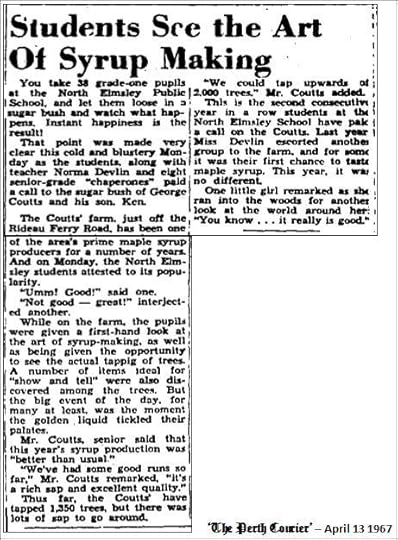
In the 1960s the Coutts family tapped about 1,300 trees yearly, and produced more than enough syrup for both the family and for area sales. Maple syrup was produced in the early 1900’s by Archibald Coutts. In 1920, George Coutts purchased an evaporator, and the production of maple syrup has continued ever since.
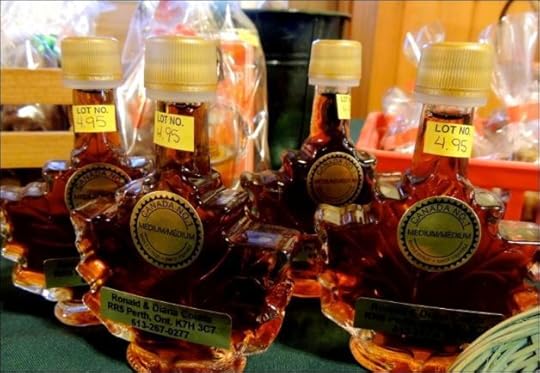
…
The ancestors of the Fulton family began to tap their maple trees back in the 1840s when John Fulton and his brothers came to Lanark County from East Kilbride, Scotland. Their large 370 acre farm is located between Almonte and Pakenham, and they have tapped their huge 4,000 tree sugar bush for many, many, generations. Well known for their high quality syrup they have also operated a pancake house for many years, and their sugar camp has been a popular attraction for both area families and visitors.

…
With these, and other long-time maple producers in Lanark County, it’s not surprising that back in the 1970s, there were lots of conversations, up and down the concessions, of hosting a maple festival in the town of Perth. It was Victor ‘Vic’ Lemieux, owner of Norvic Lodge, at Christie Lake, who first came up with the idea, and presented it to the Perth Chamber of Commerce. Thankfully, Vic was successful in his campaign to launch the first festival, with the hope that it would bring people out to celebrate the spring season, after a long, cold, winter.

On April 19, 1975 the very first Festival of the Maples was held in Perth and it was quite an event!
When my friends and I arrived at the very first Maple Festival that Saturday so long ago, part of Gore Street and Foster Street had been closed to traffic, and many local maple vendors had set up their displays. At 10 a.m. the Festival was officially opened by the Ontario Minister of Industry – Claude Bennett. The Perth Legion ladies, and the ladies from St. Andrew’s Presbyterian Church had displays of delicious home baking for sale, and there were also side-walk sales on Gore Street, and many arts and craft exhibits.
There were a tremendous number of district producers, and many of them offered syrup for sale in different grades, and various sized containers. Pancakes were available for purchase, and free samples of Balderson Cheese were available to anyone who asked, and I recall we went back a couple of times to that booth! One of the most unique displays was a wood-burning evaporator set up on one of the main streets of Perth. I’ve seen a few of those out in the bush, but I never thought I’d see one in town on the main street!
Fiddling and step-dancing competitions were held that day, and I recall Dawson Girdwood saying that some of the best fiddlers from Eastern Ontario were competing in the Open and Junior fiddling classes. The talented Jimmy Heney, one of our neighbours, won the fiddling prize hands down, as he often did, and Karen Grey of Perth was the top step-dancer that night.
The folks in Perth were always enthusiastic supporters of a beauty competition, and so part of the evening program, at the arena that night ,was the crowning of ‘The Sweetest Girl in Lanark County’. Miss Perth 1975 Michelle Hughes crowned the winner – Maple Queen – Susan Thompson, of Perth.
Over the years, we attended the Perth Maple Festival, and each spring it seemed to grow by leaps and bounds. Every year it seemed that there were more vendors selling their maple goods, more artisans displaying their crafts, and an increasing number of booths and displays. We also noticed a steady stream of tourists coming from Ottawa, Kingston, and even as far away as the States to visit our festival.

People in Lanark County, understandably, have always taken their maple syrup very seriously. Because of this, it was devastating to many when January of 1998 brought the most destructive ice storm in Canadian history. From January 4th to 10th Lanark County was severely affected by freezing rain, and ice pellets. Day after day it fell, and accumulated on tree branches, bending their limbs until they snapped off with the weight of the ice. The relentless freezing rain created a thick, heavy coat, damaging both the maple trees and the pipelines in the sugar bushes. Millions of tree branches were caked with the build-up of ice, and became so heavy that they split right off of the trees; severely affecting the sap flow. At the time, there were speculations that it might take forty years for maple production to return to normal.
Through hard work, and good fortune, many of the damaged trees came back, and the maple production resumed within a few years of the ice storm.
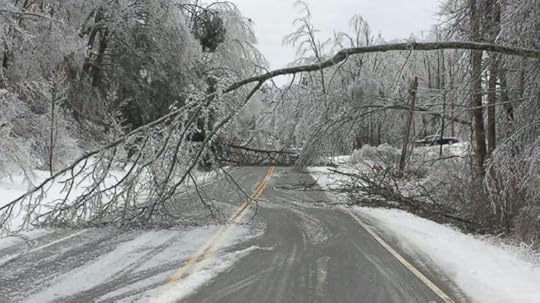
Many of us, raised in Lanark County, have participated in making maple syrup at one time or another, and know from experience that it’s extremely labour-intensive. We also have a clear understanding of the enormous amount of sap it takes to make a very small quantity of syrup. No matter how modern the equipment or methods, it still takes forty gallons of sap to make one gallon of syrup.

Now, add in the hours of labour for the tapping, transporting from the tree to the evaporator, the boiling down, the straining, the bottling, and the labeling. Next, factor in the cost of equipment such as the spiles, the pails or tubing, the evaporation tank, fuel, the straining equipment, the bottles, cans, and cost of transporting to market. The price per gallon really doesn’t sound like all that much anymore now, does it?
So, the next time you pass by the maple syrup display in your grocery store aisles, or visit a maple vendor at his farm, or at a festival, please remember how it’s produced.
Pause a moment, to remember the proud, hard-working, pioneer families who settled in Lanark County, and passed down their knowledge through the generations. Think of the enormous quantity of sap required to make a very small container of syrup. Most of all, please stop and consider the origin of your syrup, and take it from this Lanark County kid – you won’t find any better, more flavourful syrup, than from the Maple Syrup Capital of Ontario!
…………..
(an excerpt from “Lanark County Chronicle: Double-Back to the Third Line” Lanark County Chronicle)ISBN 978-0-9877026-2-3…
January 16, 2021
Ottawa Valley Poltergeist

This eerie tale began in the autumn of 1889, on a farm, owned by George Dagg, and his wife, Susan, located in Clarendon, 10 kilometers from Shawville, Quebec.
George and Susan had three children at that time, Eliza, age 4, Mary, age 3, and baby John. The Dagg family had also taken in a young girl, 11-year old Dinah. Like many orphans from the U.K. at that time, she was brought to Canada, and these children were often placed in farm homes, where they could help out.
When Dinah was present, there were often unexplained, spontaneous fires — eight occurring in a single day. Objects – a water jug, butter tub and wash basin ‘flew’ around the property controlled by an “invisible agency.” Stones were thrown through windows, a harmonica played on its own, and an empty rocking chair, rocked back and forth.
Family members and neighbours heard a deep gruff voice, sounding like an old man, in the house and outdoors, and the voice answered questions, and was heard by all.
It all began on September 15, 1889…..
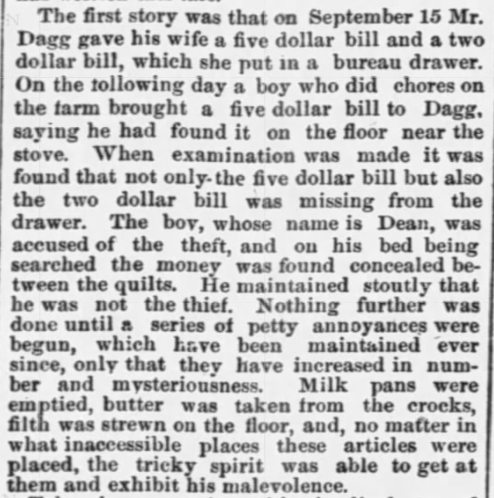
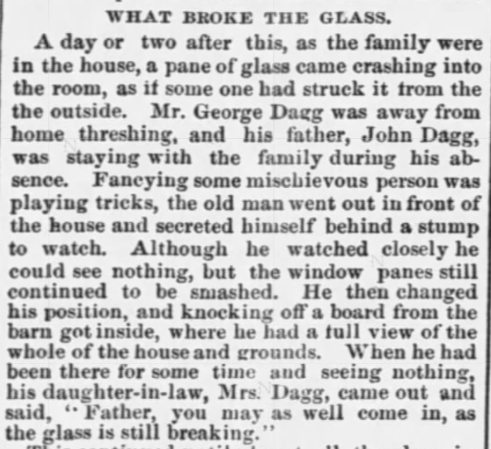
“Oh, Grandmother, see the big black thing pulling off the bedclothes.”
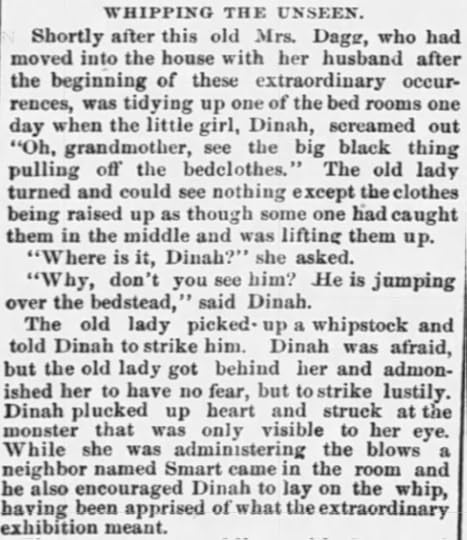
The Dagg Family Consulted with The Witch of Plum Hollow
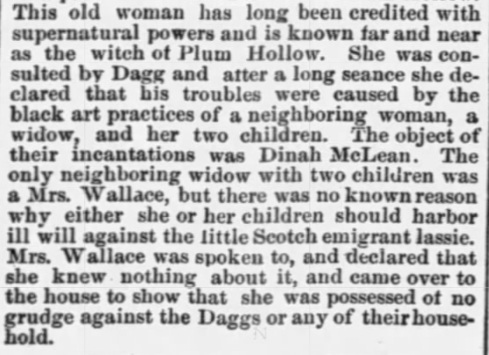
Percy Woodcock, of Brockville, a well-known artist, and student of Psychology, began to investigate the strange occurrences at the Dagg home…..

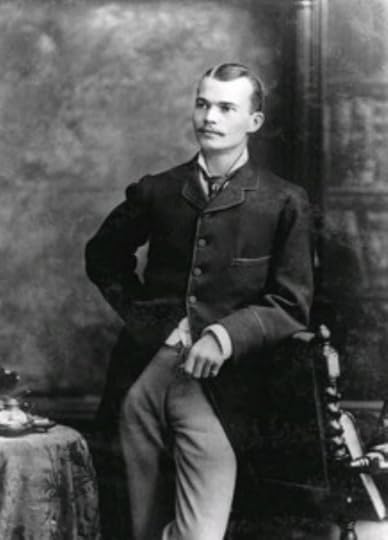 Percy Woodcock, 1879
Percy Woodcock, 1879Was it the farm-hand, Dean?
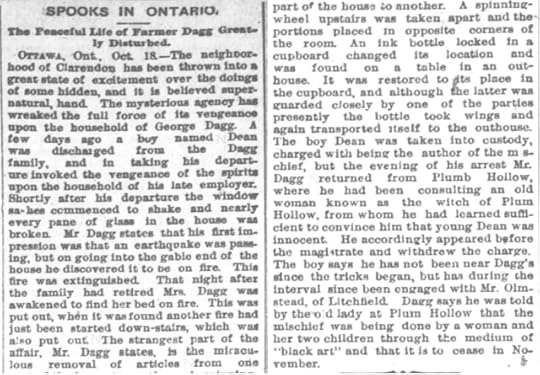
Some claimed it was Dinah…
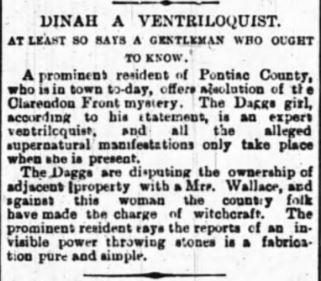
Dinah Burden McLean, the adopted orphan from Scotland, taken in by the kindly Dagg family, was blamed for the disturbances, and eventually was sent away to Fairknowe Home, in Brockville. Fairknowe Home was an orphanage, and at the time Dinah was sent there, it was called The National Orphan Homes of Scotland, and later the building housed a division of the Brockville Children’s Aid.

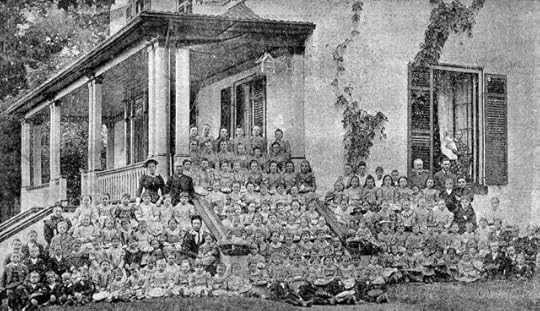

“He claims to be a discarnated being who died twenty years ago, aged eighty years; that he gave his name to Mr. George Dagg and to Mr. Willie Dagg, forbidding them to tell it.”
Seventeen farmers and community leaders, including local politicians and clergymen, signed witness statements to the unusual sightings, and voices heard at the Dagg farm, in the fall of 1889.
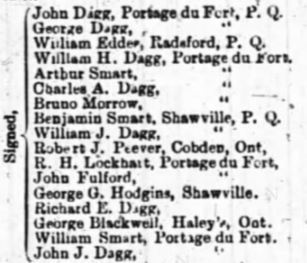
Seventeen people witnessed the disturbances of the Poltergeist, and signed a statement to that effect…
“To whom it may concern:
We, the undersigned, solemnly declare that the following curious proceedings, which began on the 15th day of September, 1889, and are still going on, on the 17th day of November, 1889, in the home of Mr. George Dagg, a farmer living seven miles from Shawville, Clarendon Township, Pontiac County, Province of Quebec, actually occurred as below described.
1st, That fires have broken out spontaneously through the house, as many as eight occurring on one day, six being in the house and two outside; that the window curtains were burned whilst on the windows, this happening in broad daylight whilst the family and neighbours were in the house.
2nd, That stones were thrown by invisible hands through the windows, as many as eight panes of glass being broken; that articles such as waterjug, milk pitcher, a wash basin, cream jug, butter tub and other articles were thrown about the house by the same invisible agency; a jar of water being thrown in the face of Mrs. John Dagg, also in the face of Mrs. George Dagg, whilst they were busy about their household duties, Mrs. George Dagg being alone in the house at the time it was thrown in her face; that a large shelf was heard distinctly to be played and was seen to move across the room on to the floor; immediately after, a rocking chair began rocking furiously. That a washboard was sent flying down the stairs from the garret, no one being in the garret at the time. That when the child Dinah is present, a deep gruff voice like that of an aged man has been heard at various times, both in the house and outdoors, and when asked questions answered so as to be distinctly heard, showing that he is cognizant of all that has taken place, not only in Mr. Dagg’s family but also in the families of the surrounding neighbourhood. That he claims to be a discarnated being who died twenty years ago, aged eighty years; that he gave his name to Mr. George Dagg and to Mr. Willie Dagg, forbidding them to tell it. That this intelligence is able to make himself visible to Dinah, little Mary and Johnnie, who have seen him under different forms at different times, at one time as a tall thin man with a cow’s head, horns and cloven foot, at another time as a big black dog, and finally as a man with a beautiful face and long white hair, dressed in white, wearing a crown with stars in it.
Signed,
John Dagg Portage du Fort, PQ.; George Dagg, Portage du Fort, PQ; William Eddes, Radsford, PQ; William H. Dagg Port. du Fort; Arthur Smart, Port. du Fort; Charles A. Dagg, Port. du Fort; Bruno Morrow, Port. du Fort; Benjamin Smart, Shawville, PQ.; William J. Dagg, Shawville, PQ.; Robert F. Peever, Cobden, Ont.; Robert H. Lockhart, Port. du Fort; John Fulfrid, Port. du Fort; George H. Hodgins, Shawville; Richard F. Dagg, Shawville; George Blackwell, Haley’s, Ont.; William Smart, Portage du Fort; John J. Dagg, Portage du Fort.”
Curiosity-seekers came by the wagon-load, from neighbouring towns and villages, along with the media, to witness the Dagg Poltergeist

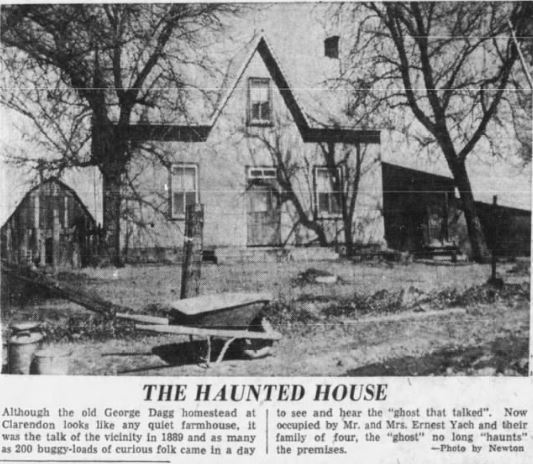
Attested by Scores of Credible Witnesses
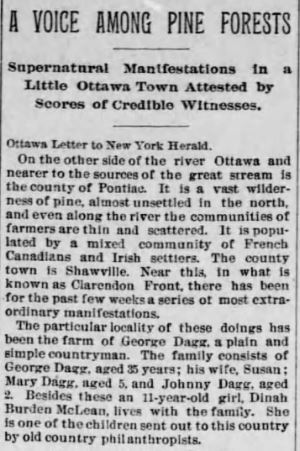
“The man left with Dinah, and she was never heard from again….”
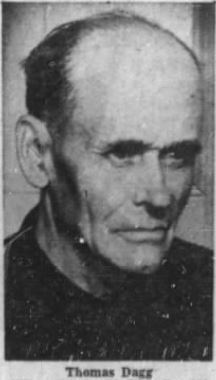
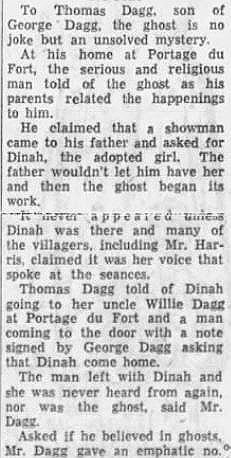
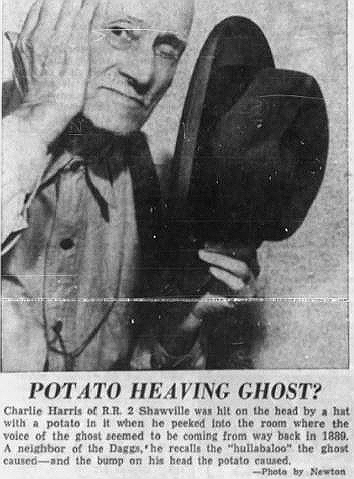
“It” threw water in Mrs. Dagg’s face…..

The Dagg House 2017
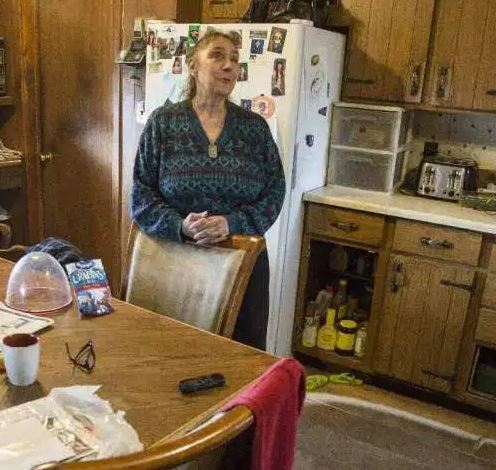
Noted by the Lombard family – a strange sound of crawling and scratching in the attic, solely focused above the original house.
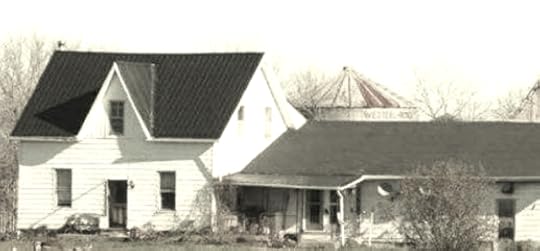
Eliza Jane, age 4, the Dagg’s daughter, died mysteriously, during the time of the poltergeist’s visit.
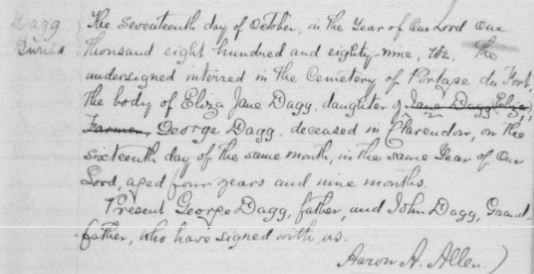
Grave of Eliza Dagg, daughter of George and Susan Dagg. She passed away in a mysterious accident, during the time of the poltergeist on the family farm. (local lore is little Eliza was playing near a cauldron of soap, her clothing caught fire, and she burned to death)
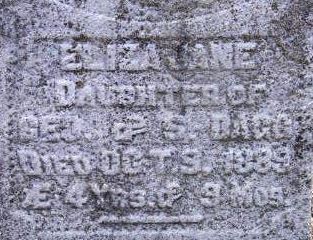
After the Poltergeist
After the disturbances of 1889, the lives of George Dagg and his family returned to normal, for the most part. George became one of the most prominent farmers in the region, and served as a Councillor for Portage from 1918-1922. Popular, and well-respected, he ran for Mayor in 1922, and was elected. He served as Mayor of Portage for 16 years, right up until his death, in 1938.
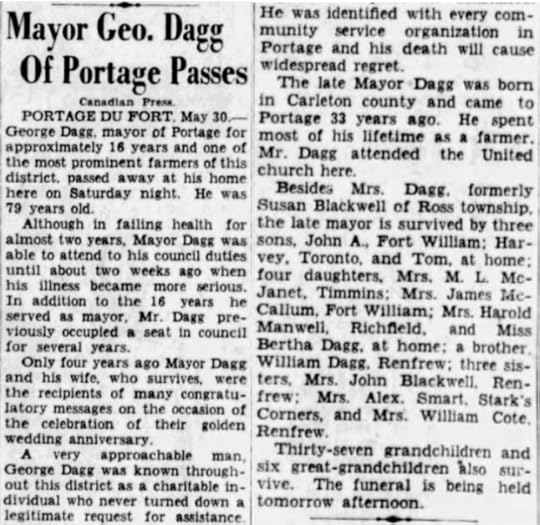
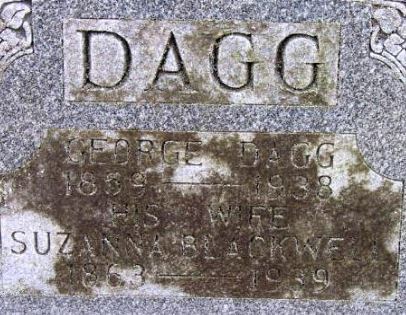
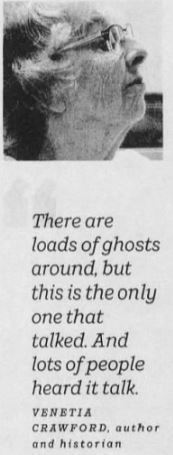
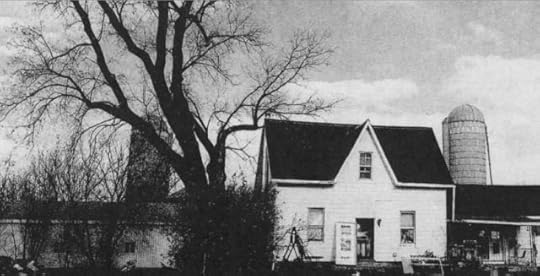
Did it vanish for good, or did it return?
The old-timers say that the poltergeist vanished, and appeared like a streaking flame, as it finally left the Dagg farm, after three long months, of troublesome behavior.
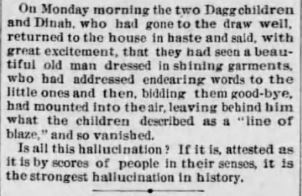
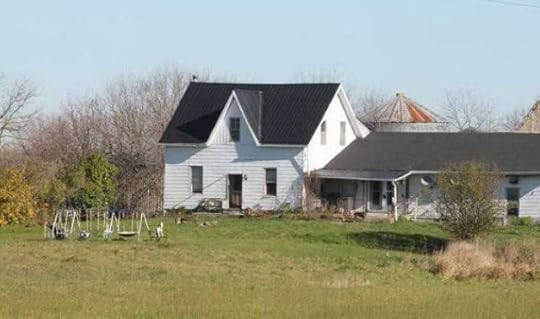
The Dagg House, as it appears today. Local people and curiosity seekers still drive by this property, and local teens have been known to walk through the yard at night, on a dare.
Would You Dare to Visit at Night?
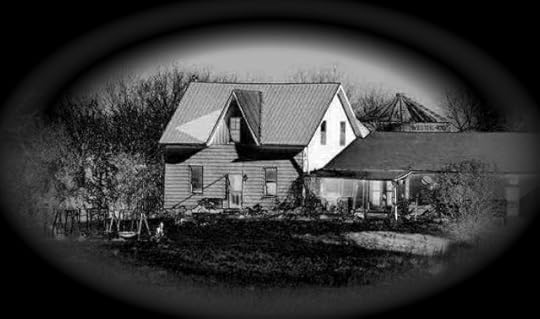
Exploring the Supernatural: The Weird in Canadian Folklore
1955. R.S Lambert’s book Exploring The Supernatural: The Weird In Canadian Folklore was published, which includes a chapter of what took place at the farm in 1889.
…..
The Ghost that Talked
The Dagg poltergeist was the subject of 1957 National Film Board movie, “The Ghost That Talked.”
“In the fall of 1889 a mysterious presence took up residence in the Dagg farmhouse in Pontiac county, Québec. This dramatization based on the first-hand report by Canadian artist Percy Woodcock shows that ghosts and poltergeists are as common in Canada as in the Old World.”
March 10th, 1957, 30 min.
…….
Fairknowe Home
For more information on Fairknowe Home, orphanage in Brockville: “The Village, A History of Quarriers” , by Anna Magnusson, 1984.
…….


